Abstract
Strains of Salmonella enterica serotype Berta, collected over a period of 6 years from a well documented natural outbreak in Denmark, have been characterized in order to assess the stability of chromosomal typing systems and virulence properties. Outbreak strains were identical in Pvu II and PSTI IS200 profiles, all but two strains showed the same Sma I ribotype, and all but one strain showed the same Not I pulsed field gel electrophoretic pattern, indicating that these molecular markers remained almost constant during the outbreak. In general, strains of S. Berta were found to be of moderate to low virulence; log VC10 values were found to vary between 3.0 and 4.4 after i.p. challenge of mice, and maximum CFU in internal organs of day-old chicks varied between 2 and 4 log10 units following oral challenge. The minor differences observed between strains in vivo did not correlate with differences in in vitro invasion into cultured MDCK cells, nor with in vitro growth characteristics. A succession of different plasmid profile types was observed during the outbreak but a hierarchical selection of clones based on differences in virulence was unlikely to have caused the succession of types of S. Berta during this outbreak.
Full text
PDF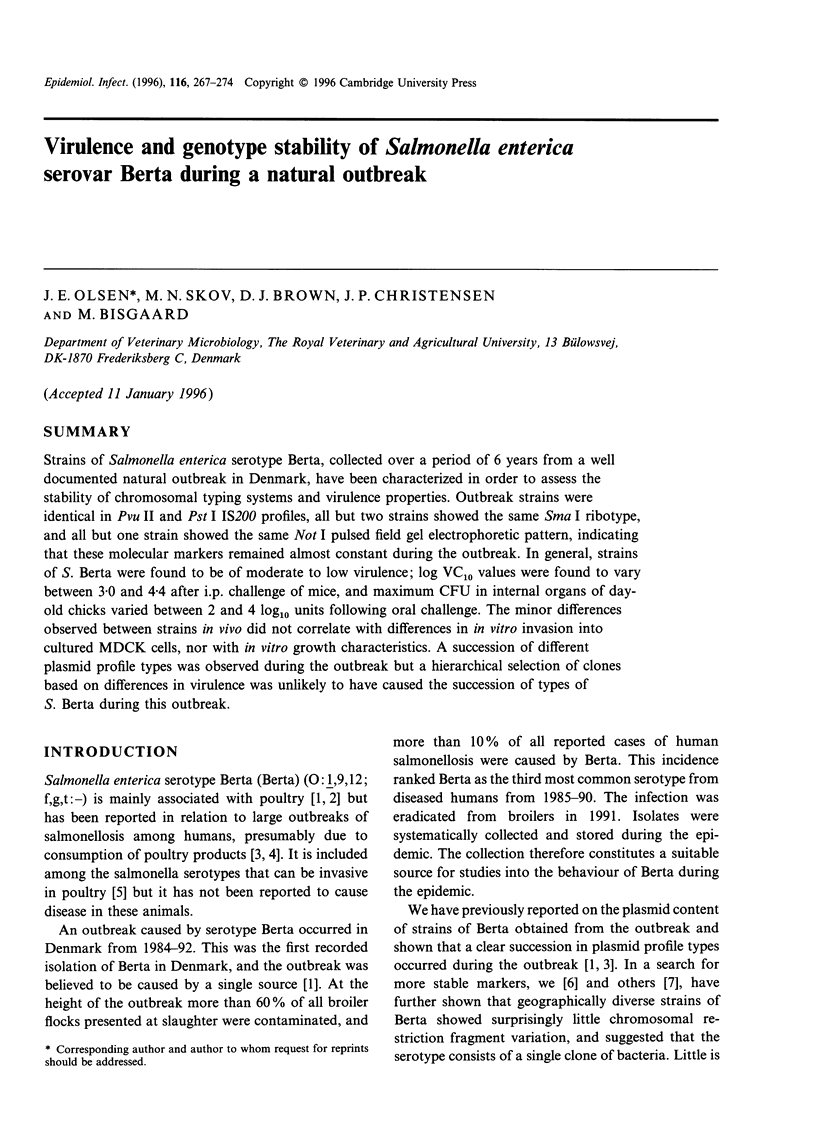
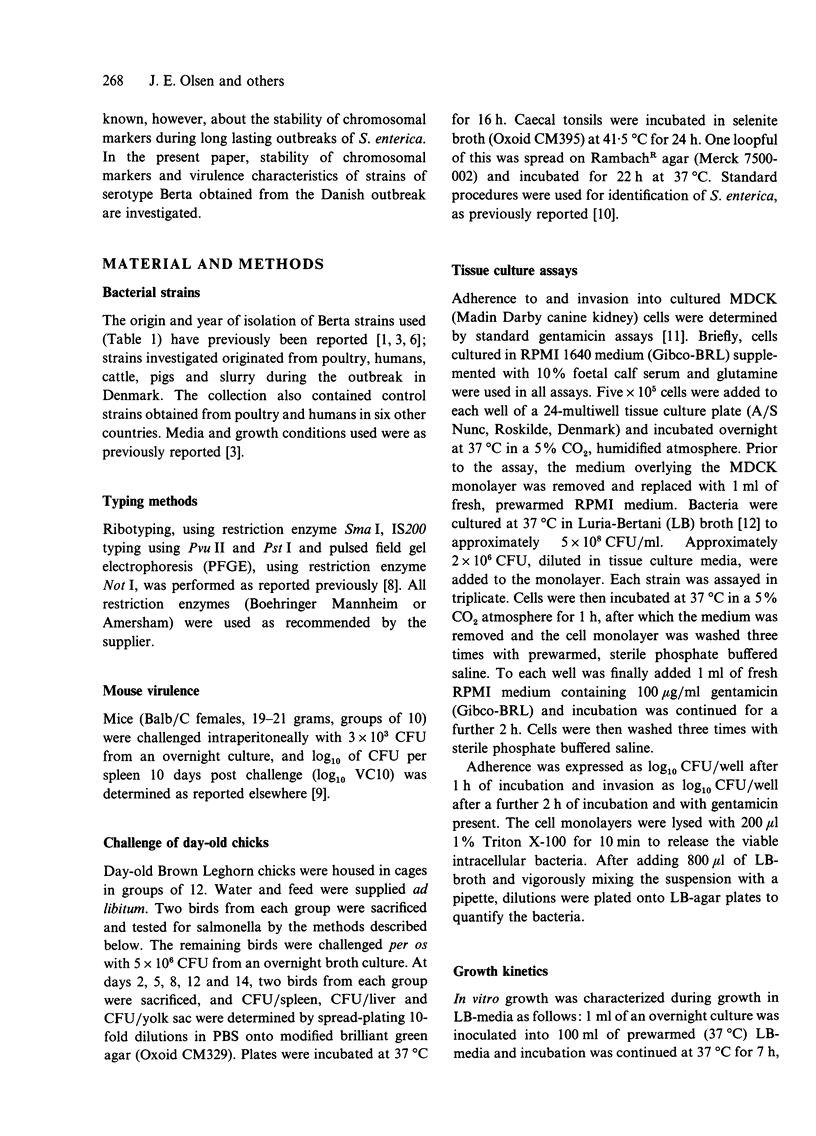
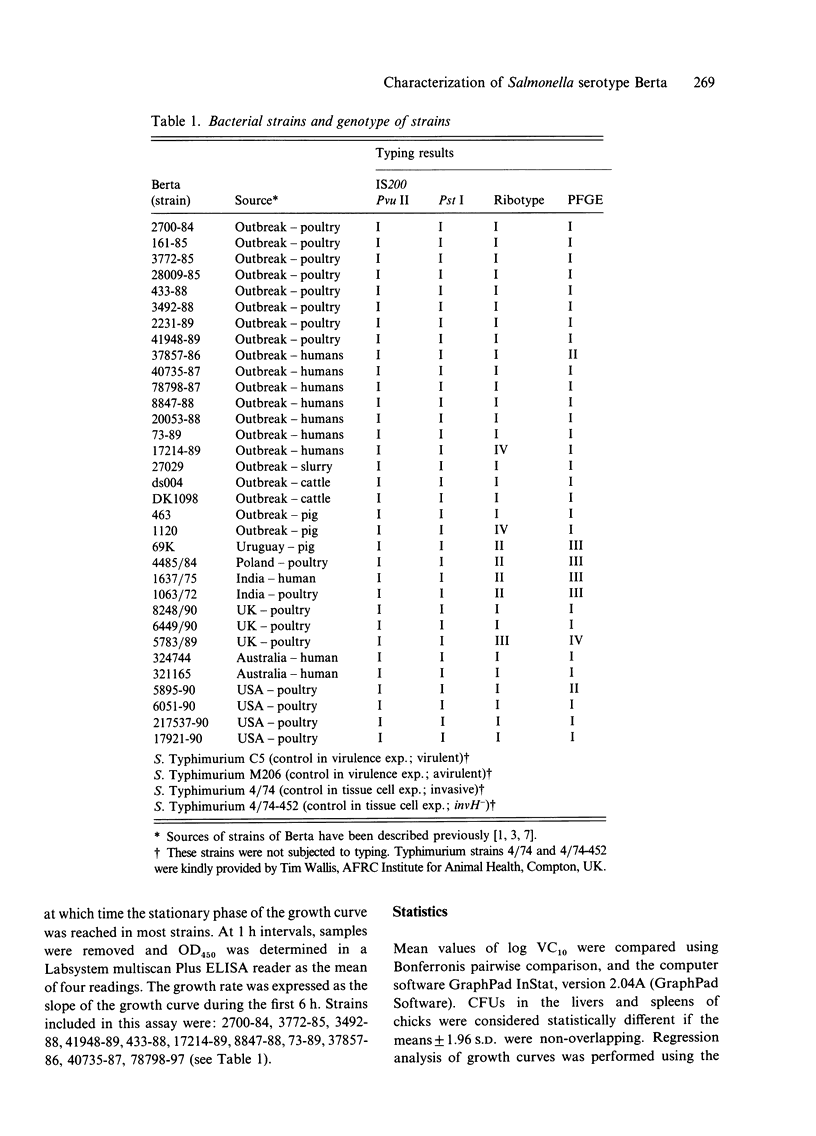
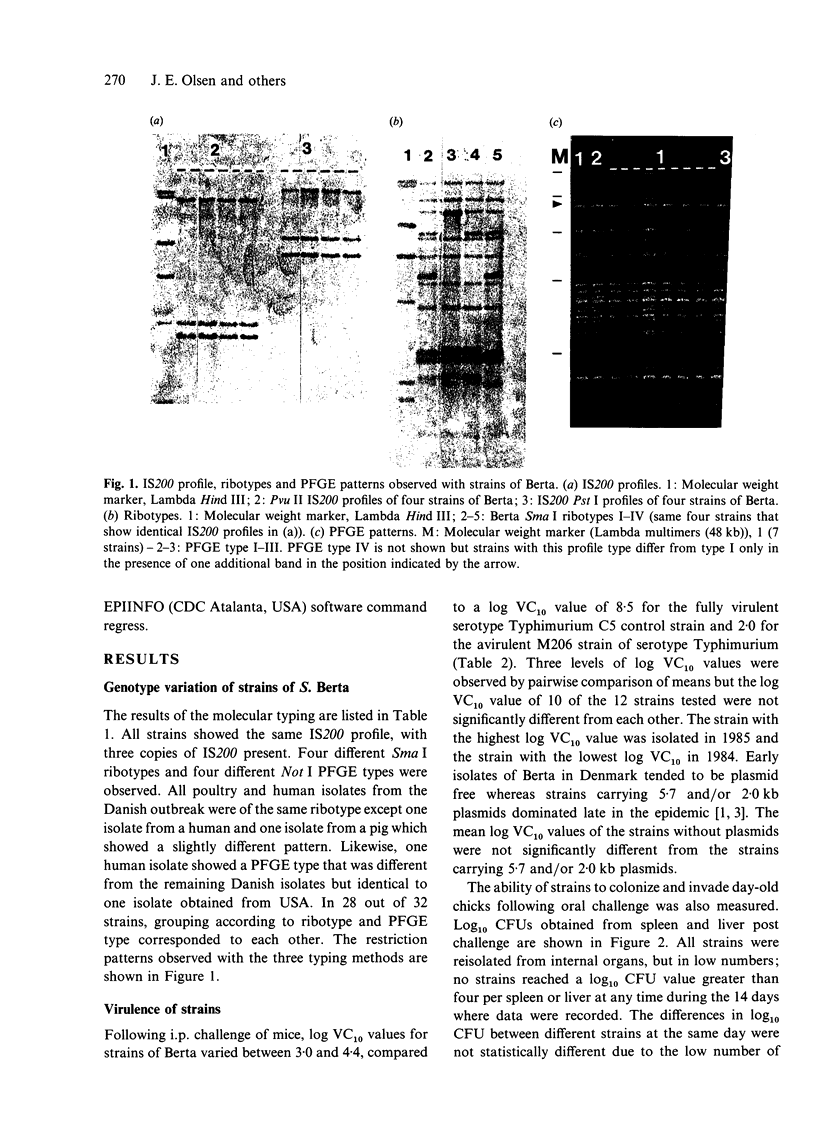
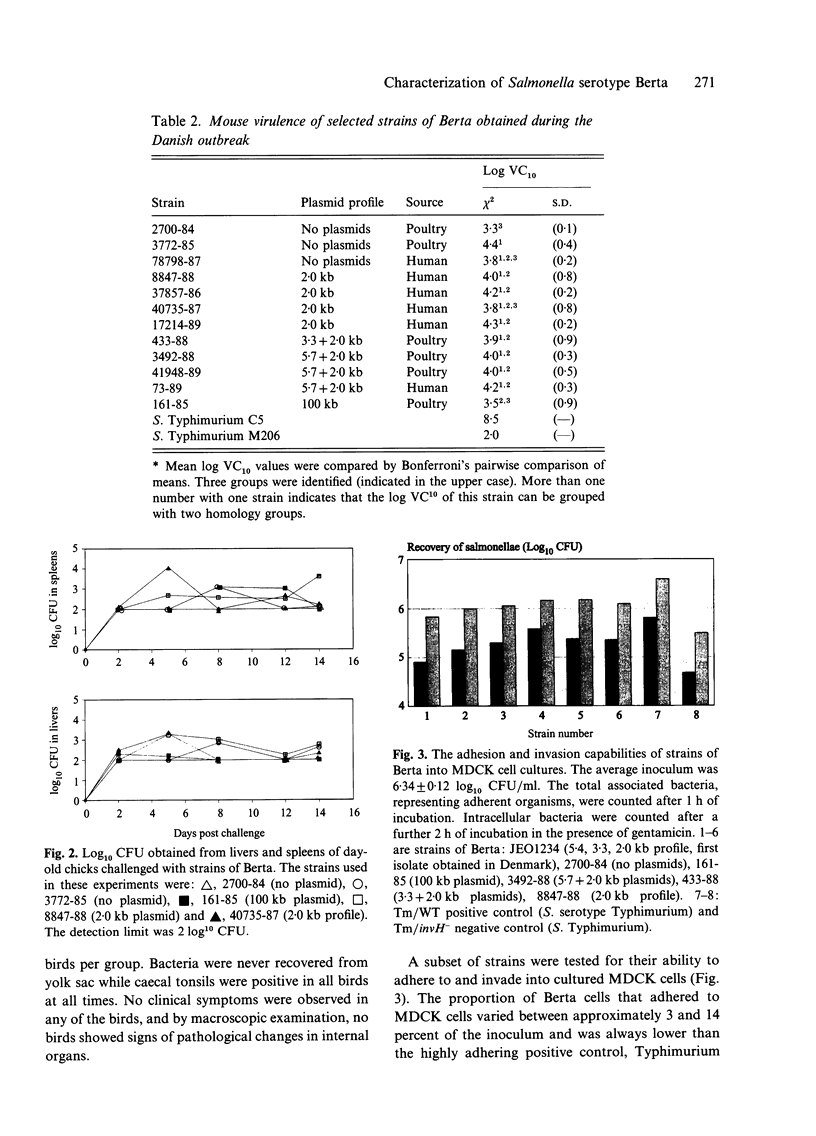
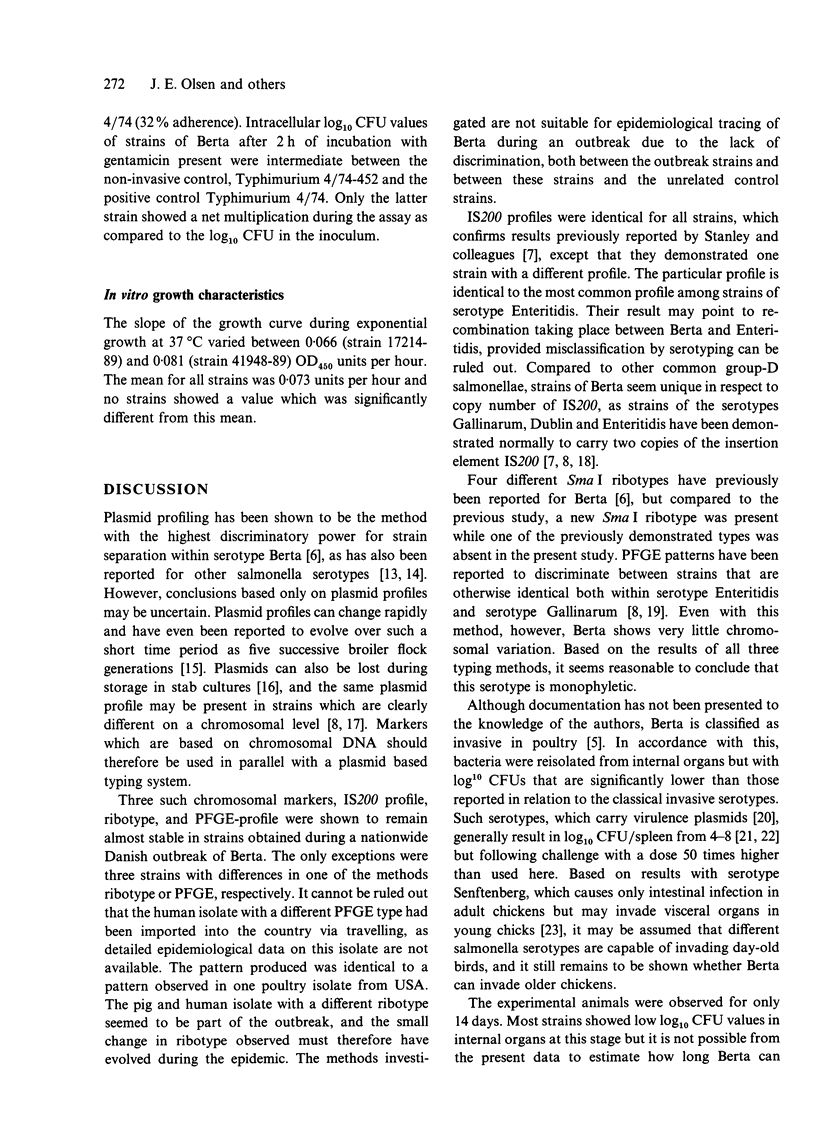
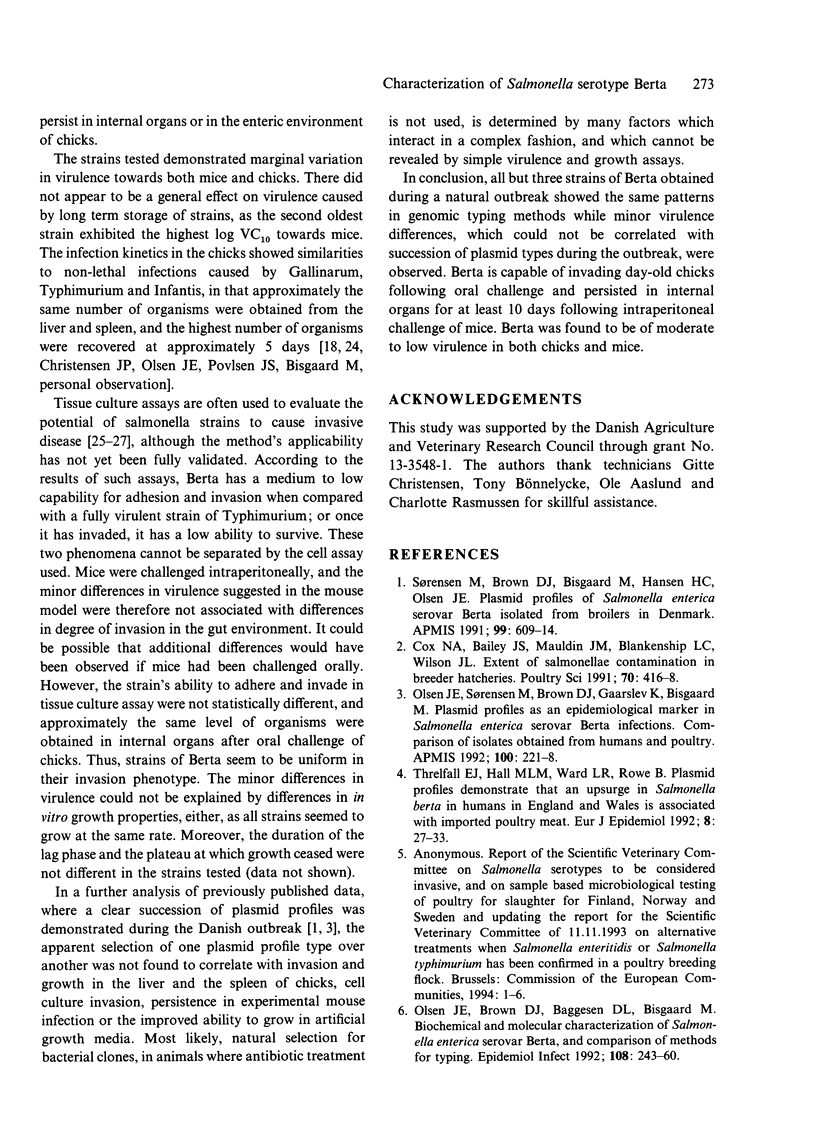
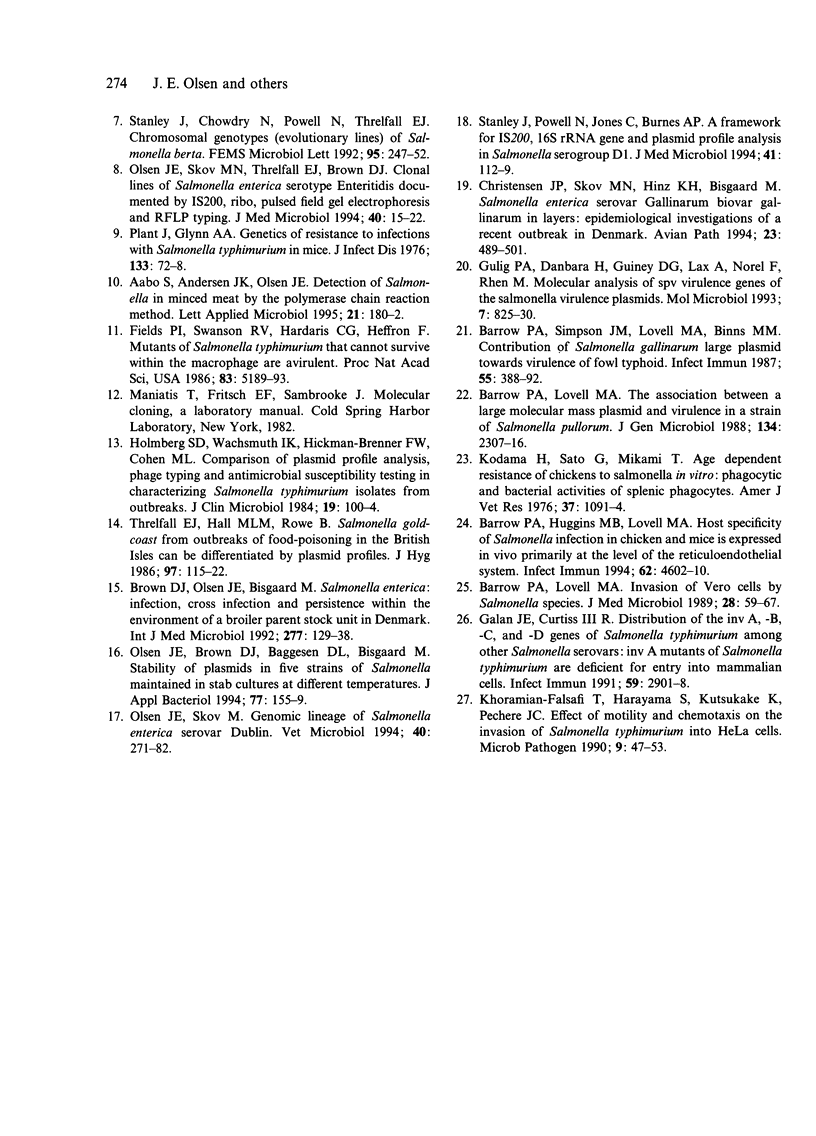
Images in this article
Selected References
These references are in PubMed. This may not be the complete list of references from this article.
- Aabo S., Andersen J. K., Olsen J. E. Research note: detection of Salmonella in minced meat by the polymerase chain reaction method. Lett Appl Microbiol. 1995 Sep;21(3):180–182. doi: 10.1111/j.1472-765x.1995.tb01036.x. [DOI] [PubMed] [Google Scholar]
- Barrow P. A., Huggins M. B., Lovell M. A. Host specificity of Salmonella infection in chickens and mice is expressed in vivo primarily at the level of the reticuloendothelial system. Infect Immun. 1994 Oct;62(10):4602–4610. doi: 10.1128/iai.62.10.4602-4610.1994. [DOI] [PMC free article] [PubMed] [Google Scholar]
- Barrow P. A., Lovell M. A. Invasion of Vero cells by Salmonella species. J Med Microbiol. 1989 Jan;28(1):59–67. doi: 10.1099/00222615-28-1-59. [DOI] [PubMed] [Google Scholar]
- Barrow P. A., Lovell M. A. The association between a large molecular mass plasmid and virulence in a strain of Salmonella pullorum. J Gen Microbiol. 1988 Aug;134(8):2307–2316. doi: 10.1099/00221287-134-8-2307. [DOI] [PubMed] [Google Scholar]
- Barrow P. A., Simpson J. M., Lovell M. A., Binns M. M. Contribution of Salmonella gallinarum large plasmid toward virulence in fowl typhoid. Infect Immun. 1987 Feb;55(2):388–392. doi: 10.1128/iai.55.2.388-392.1987. [DOI] [PMC free article] [PubMed] [Google Scholar]
- Brown D. J., Olsen J. E., Bisgaard M. Salmonella enterica: infection, cross infection and persistence within the environment of a broiler parent stock unit in Denmark. Zentralbl Bakteriol. 1992 Jun;277(1):129–138. doi: 10.1016/s0934-8840(11)80881-9. [DOI] [PubMed] [Google Scholar]
- Cox N. A., Bailey J. S., Mauldin J. M., Blankenship L. C., Wilson J. L. Extent of salmonellae contamination in breeder hatcheries. Poult Sci. 1991 Feb;70(2):416–418. doi: 10.3382/ps.0700416. [DOI] [PubMed] [Google Scholar]
- Fields P. I., Swanson R. V., Haidaris C. G., Heffron F. Mutants of Salmonella typhimurium that cannot survive within the macrophage are avirulent. Proc Natl Acad Sci U S A. 1986 Jul;83(14):5189–5193. doi: 10.1073/pnas.83.14.5189. [DOI] [PMC free article] [PubMed] [Google Scholar]
- Galán J. E., Curtiss R., 3rd Distribution of the invA, -B, -C, and -D genes of Salmonella typhimurium among other Salmonella serovars: invA mutants of Salmonella typhi are deficient for entry into mammalian cells. Infect Immun. 1991 Sep;59(9):2901–2908. doi: 10.1128/iai.59.9.2901-2908.1991. [DOI] [PMC free article] [PubMed] [Google Scholar]
- Gulig P. A., Danbara H., Guiney D. G., Lax A. J., Norel F., Rhen M. Molecular analysis of spv virulence genes of the Salmonella virulence plasmids. Mol Microbiol. 1993 Mar;7(6):825–830. doi: 10.1111/j.1365-2958.1993.tb01172.x. [DOI] [PubMed] [Google Scholar]
- Holmberg S. D., Wachsmuth I. K., Hickman-Brenner F. W., Cohen M. L. Comparison of plasmid profile analysis, phage typing, and antimicrobial susceptibility testing in characterizing Salmonella typhimurium isolates from outbreaks. J Clin Microbiol. 1984 Feb;19(2):100–104. doi: 10.1128/jcm.19.2.100-104.1984. [DOI] [PMC free article] [PubMed] [Google Scholar]
- Khoramian-Falsafi T., Harayama S., Kutsukake K., Pechère J. C. Effect of motility and chemotaxis on the invasion of Salmonella typhimurium into HeLa cells. Microb Pathog. 1990 Jul;9(1):47–53. doi: 10.1016/0882-4010(90)90039-s. [DOI] [PubMed] [Google Scholar]
- Kodama H., Sato G., Mikami T. Age-dependent resistance of chickens to salmonella in vitro: phagocytic and bactericidal activities of splenic phagocytes. Am J Vet Res. 1976 Sep;37(9):1091–1094. [PubMed] [Google Scholar]
- Olsen J. E., Brown D. J., Baggesen D. L., Bisgaard M. Biochemical and molecular characterization of Salmonella enterica serovar berta, and comparison of methods for typing. Epidemiol Infect. 1992 Apr;108(2):243–260. doi: 10.1017/s0950268800049724. [DOI] [PMC free article] [PubMed] [Google Scholar]
- Olsen J. E., Brown D. J., Baggesen D. L., Bisgaard M. Stability of plasmids in five strains of Salmonella maintained in stab culture at different temperatures. J Appl Bacteriol. 1994 Aug;77(2):155–159. doi: 10.1111/j.1365-2672.1994.tb03059.x. [DOI] [PubMed] [Google Scholar]
- Olsen J. E., Skov M. N., Threlfall E. J., Brown D. J. Clonal lines of Salmonella enterica serotype Enteritidis documented by IS200-, ribo-, pulsed-field gel electrophoresis and RFLP typing. J Med Microbiol. 1994 Jan;40(1):15–22. doi: 10.1099/00222615-40-1-15. [DOI] [PubMed] [Google Scholar]
- Olsen J. E., Skov M. Genomic lineage of Salmonella enterica serovar Dublin. Vet Microbiol. 1994 Jun;40(3-4):271–282. doi: 10.1016/0378-1135(94)90116-3. [DOI] [PubMed] [Google Scholar]
- Olsen J. E., Sørensen M., Brown D. J., Gaarslev K., Bisgaard M. Plasmid profiles as an epidemiological marker in Salmonella enterica serovar berta infections. Comparison of isolates obtained from humans and poultry. APMIS. 1992 Mar;100(3):221–228. [PubMed] [Google Scholar]
- Plant J., Glynn A. A. Genetics of resistance to infection with Salmonella typhimurium in mice. J Infect Dis. 1976 Jan;133(1):72–78. doi: 10.1093/infdis/133.1.72. [DOI] [PubMed] [Google Scholar]
- Stanley J., Chowdry N., Powell N., Threlfall E. J. Chromosomal genotypes (evolutionary lines) of Salmonella berta. FEMS Microbiol Lett. 1992 Aug 15;74(2-3):247–252. doi: 10.1016/0378-1097(92)90437-s. [DOI] [PubMed] [Google Scholar]
- Stanley J., Powell N., Jones C., Burnens A. P. A framework for IS200, 16S rRNA gene and plasmid-profile analysis in Salmonella serogroup D1. J Med Microbiol. 1994 Aug;41(2):112–119. doi: 10.1099/00222615-41-2-112. [DOI] [PubMed] [Google Scholar]
- Sørensen M., Brown D. J., Bisgaard M., Hansen H. C., Olsen J. E. Plasmid profiles of Salmonella enterica serovar berta isolated from broilers in Denmark. APMIS. 1991 Jul;99(7):609–614. [PubMed] [Google Scholar]
- Threlfall E. J., Hall M. L., Rowe B. Salmonella gold-coast from outbreaks of food-poisoning in the British Isles can be differentiated by plasmid profiles. J Hyg (Lond) 1986 Aug;97(1):115–122. doi: 10.1017/s0022172400064408. [DOI] [PMC free article] [PubMed] [Google Scholar]
- Threlfall E. J., Hall M. L., Ward L. R., Rowe B. Plasmid profiles demonstrate that an upsurge in Salmonella berta in humans in England and Wales is associated with imported poultry meat. Eur J Epidemiol. 1992 Jan;8(1):27–33. doi: 10.1007/BF02427388. [DOI] [PubMed] [Google Scholar]




